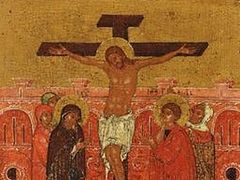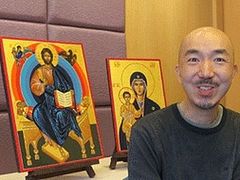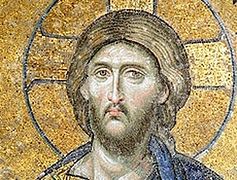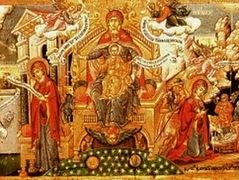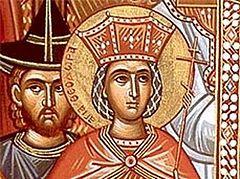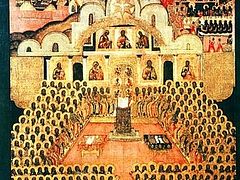Source: Antiochian Orthodox Christian Archdiocese
of North America
by Fr. Jack N. Sparks, Ph.D.
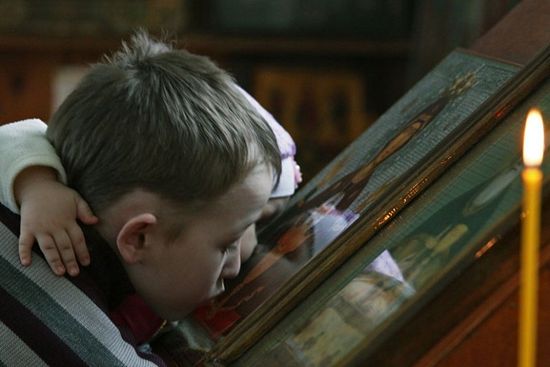 Photo: A.Kolosov / Pravoslavie.ru
Photo: A.Kolosov / Pravoslavie.ru
The first time I invited a particular Protestant friend to step inside an Orthodox Church, he looked around very slowly, carefully, cautiously. “It’s pretty,” he said, “but doesn’t the Bible warn against graven images?”
His reference, of course, was to the icons, painted images of Jesus Christ and His followers who, through the centuries of our history as the Church, have been portrayed for all to see. Was he right in his concern?
That particular Church, like most Orthodox Churches, was very beautiful. And the Bible, specifically the Old Testament law, does say, “Thou shalt have no graven images” (Exodus 20:4, KJV). So, the question is, do those icons, those paintings portraying Christ, His Mother, the saints, and special biblical events, come under the category of graven images?
The history of icons and of their use in the Orthodox Church is not only fascinating but instructive. They are no new thing. Nor were they invented by an apostate medieval Church. The use of representations for instruction and as aids to piety goes back to the earliest centuries of the Church, and likely they were there in some form from the very beginning. Certainly we know that even in legal-minded Israel, paintings and other artistic representations used to help the people remember spiritual truth were not at all unknown.
In both the tabernacle and the later temples there were images used, especially of the cherubim. And a recently unearthed synagogue of the last few centuries before Christ has paintings of biblical scenes on its walls.
The Biblical Parameters
But was this done contrary to the command of God? Look at Exodus 26:1. In God’s commands to Moses concerning the tabernacle, given just a few chapters after the giving of the Ten Commandments, is this instruction: “Moreover you shall make the tabernacle with ten curtains woven of fine linen thread, and blue and purple and scarlet yarn; with artistic designs of cherubim you shall weave them.”
A similar command with respect to the Ark of the Covenant instructed Moses to have two cherubim of hammered gold at the ends of the mercy seat. God said, “And there I will meet with you, and I will speak with you from above the mercy seat, from between the two cherubim which are on the ark of the Testimony, of all things which I will give you in commandment to the children of Israel” (Exodus 25:22). Here are images directly connected with the presence of God, and commanded by Him.
From the very earliest years of the Church, Christians used such symbols as the cross, the fish, the peacock, the shepherd, and the dove. And early Christian tombs and catacombs bear paintings which are representations of biblical scenes.
For example, the fourth century Church historian Eusebius tells us that outside the house of the woman in the Gospels with a hemorrhage cured by Christ was “a bronze statue of a woman, resting on one knee and resembling a suppliant with arms outstretched. Facing this was another of the same material, an upright figure of a man with a double cloak draped neatly over his shoulders and his hand stretched out to the woman.”
Eusebius goes on to say, “This statue, which was said to resemble the features of Jesus, was still there in my own time, so that I saw it with my own eyes” (Church History, Book 7, Chapter 18). He tells us further that portraits of the Savior and of Peter and Paul had been preserved, and that he had examined these with his own eyes as well.
In that very same century the famous bishop and theologian, Saint Gregory of Nyssa, tells of being deeply moved by an icon of the sacrifice of Isaac: “I have seen a painted representation of this passion, and have never passed by without shedding tears, for art brings the story vividly to the eyes.” His friend and contemporary, Saint Gregory Nazianzen, writes of the persecution of Christians by the cruel Emperor Julian the Apostate: “The images venerated in public places still bear scars of that plague.” The witness of many other great early Church writers bears out the same truth. Icons were known and venerated in the earliest centuries of the Church.
All right. So the early Church made and possessed images—or icons, as we call them in a transliteration of the Greek word for images. And the Christian faithful honored or venerated them. But does this fit with the biblical warning concerning images?
The command in question is from the Ten Commandments: “You shall have no other gods before Me. You shall not make for yourself any carved image, or any likeness of anything that is in heaven above, or that is in the earth beneath, or that is in the water under the earth; you shall not bow down to them nor serve them. For I, the Lord your God, am a jealous God” (Exodus 20:3-5).
Note that the context shows that the term “graven image” is used to refer to an idol—an image created to be worshiped as a god. Could this mean there are in the Bible two classifications of image—true images and false images? Appropriate images and inappropriate images? If so, how do we distinguish between them?
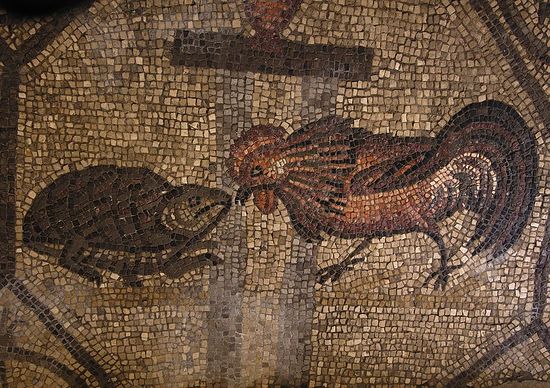 Ancient mosaic in the Patriarchal Basilica of Aquileia, Italy. Photo: D.Tsypin / Ptavoslavie.ru
Ancient mosaic in the Patriarchal Basilica of Aquileia, Italy. Photo: D.Tsypin / Ptavoslavie.ru
Icons and Our Faith in God
To answer these questions, let us review for a moment what we believe about God Himself. The venerable eighth-century theologian, Saint John of Damascus—a champion for the cause of icons and for Orthodox Christianity—summarizes very well what true Christians in his day believed about God. See if you don’t agree.
“I believe in one God, the source of all things, without beginning, uncreated, immortal and unassailable, eternal, everlasting, incomprehensible, bodiless, invisible, uncircumscribed, without form. I believe in one superessential Being, one Godhead greater than our conception of divinity, in three persons: Father, Son, and Holy Spirit, and I adore Him alone. I worship one God, one Godhead, but I adore three persons: God the Father, God the Son made flesh, and God the Holy Spirit, one God” (On the Divine Images, Crestwood, NY: St. Vladimir’s Seminary Press, 1980, page 15).
Nothing could be more sound, more biblical, more Christian, more Orthodox. But given our understanding of the Godhead, if God is invisible, as Saint John writes, how can we possibly depict God?
Listen once again to Saint John of Damascus: “It is obvious that when you contemplate God becoming man, then you may depict Him clothed in human form. When the invisible One becomes visible to flesh, you may then draw His likeness. When He who is bodiless and without form, immeasurable in the boundlessness of His own nature, existing in the form of God, empties Himself and takes the form of a servant in substance and in stature and is found in a body of flesh, then you may draw His image and show it to anyone willing to gaze upon it” (On the Divine Images,page 18).
The old Chinese adage, “A picture is worth a thousand words,” comes to mind. If we use word-pictures to illustrate our sermons, what about graphic pictures to illustrate the gospel of Christ itself? This is Saint John’s plea: “Depict His wonderful condescension, His birth from the Virgin, His baptism in the Jordan, His transfiguration on Tabor, His sufferings which have freed us from passion, His death, His miracles which are signs of His divine nature, since through divine power He worked them in the flesh. Show His saving cross, the tomb, the resurrection, the ascension into the heavens. Use every kind of drawing, word, or color” (On the Divine Images, page 18).
Absolutely! Right on target! It is incredibly important that we Christians be allowed the latitude to depict Christ’s humanity and work, because by His incarnation He revealed Himself in and through material creation. And material creation thus sanctified must be allowed to reveal Him.
To Whom Honor Is Due
But suppose you saw me kneeling before an array of icons of the scenes Saint John described, praying to Christ—perhaps even kissing those icons. What then? Am I engaged in the worship of idols?
For here, you see, is where we come across the crucial reason for having icons in the first place. In the image we see the Prototype. An icon of Christ reveals to us the Original. And through Him, He taught us, we also glimpse the Father. Icons become for us windows to heaven, revealing the glory of God. The fact is, icons help to protect us from idolatry! Thus, we bow before the icon of Christ, seeing through it Him and His Father.
These icons, these windows, may be seen as offering movement in two directions. In an Orthodox Church the icons are for us who worship a passage into the Kingdom of God, but they also bring a revelation, a manifestation of the unseen heavenly host of angels, saints, and martyrs—yes, even the eternal saving events—into our presence. The Church becomes a true outpost of heaven on earth.
This veneration, by the way, is accompanied by rich scriptural precedent. Saint John of Damascus reminds us that: “Abraham bowed down to the sons of Hamor, men who had neither faith nor knowledge of God, when he bought the double cave intended to become a tomb. Jacob bowed to the ground before Esau, his brother, and also before the tip of his son Joseph’s staff. He bowed down, but he did not adore. Joshua, the son of Nun, and Daniel bowed in veneration before an angel of God, but they did not adore him” (On the Divine Images, page 19).
Wisdom. In that perceptive statement lies a choice of words that makes all the difference in the world to Orthodox Christians when it comes to their use of icons. A major distinction is made between adoration or worship and honor or veneration. Worship is reserved only for God. Honor and veneration are given more broadly, a different matter entirely.
We all honor and venerate various objects, positions, and people—and that to differing degrees! Husbands and wives are told in the New Testament to honor each other. And likewise children honor (we hope!) their parents. At school we honor teachers and principals. We honor professors and scientists; governors and members of congress; senators and judges; presidents and prime ministers. “Take a letter to the Honorable Mr. Jones,” a man may say to his secretary.
The word “venerate” is less familiar today, perhaps because we do less venerating than earlier generations. The verb “to venerate” means to regard with reverential respect or with admiration. I asked my friend how he felt about the Bible. Did he feel any more respect for it than for any other book, say a dictionary or a novel? “Yes,” he said emphatically, “the Bible is the word of God, so I respect it above any other book.”
“Well, then,” I asked, “would you say you venerate the Bible?” He thought it was a very strong word, but when it came right down to it, yes, he did venerate the Bible.
“What, then, about your pastor,” I asked, “or some other very pious or spiritual person you know? Is there someone like that whom you venerate?” There he wasn’t sure. He did respect his pastor and some other Christians he knew, respected them very highly, but it seemed that “venerate” was a word too strong.
Even though we Americans are uneasy about veneration, many of us are still willing to venerate the Bible, and, yes, some even know what it is to venerate a wise and godly pastor or an aged grandparent. So indeed do Orthodox Christians venerate icons, honoring and respecting them for what they depict, for the story they tell, for what they reveal of heaven and of the glory of God.
“But wait,” said my friend, “If you are going to worship God, why don’t you just worship God?” Our discussion led to a consideration of what he would consider the ideal environment for worship: four blank, undecorated walls in a neutral but pleasant color, and a pulpit. Would such severe bareness serve to speak of the presence of a living God? Even bare walls are an image, speaking of absence and emptiness.
How one worships, you see, is a crucial concern for a Christian. And icons are central to Orthodox Christian worship. Not only do they help us to see the glory of God, but some icons, such as those of the saints, give us holy models to follow as patterns for our lives.
Our primary example, of course, is Christ Himself, who said, “A new commandment I give to you, that you love one another; as I have loved you, that you also love one another” (John 13:34). And Saint Paul wrote, “Therefore be followers of God as dear children. And walk in love, as Christ also has loved us and given Himself for us, an offering and a sacrifice to God for a sweet-smelling aroma” (Ephesians 5:1, 2).
But the Apostle Paul even exhorted his readers to follow or imitate him (1 Corinthians 4:16; 11:1; Philippians 3:17; 4:9). And throughout the ages of the Church, sensible believers have seen that following godly men and women who have gone before is a help in personal growth toward the image and likeness of God. When Orthodox Christians honor an icon of one of the saints by bowing before it, kissing it, and saying a prayer before it, they are intent upon the godly example of that saint and upon following that example.
The Word Becomes Flesh
Orthodox worship is made up almost entirely of Scripture readings, prayers, and hymns. And the movements we make in connection with some of these readings, prayers, and hymns, are movements which turn our eyes and our attention to certain icons. This direction of our attention to the icons is central to the purpose of Orthodox Christian worship: to direct us to Christ, who directs us to the Father. This, after all, is why the Son and Word of God became incarnate. As He Himself said: “He who believes in Me, believes not in Me but in Him who sent Me. And he who sees Me sees Him who sent Me” (John 12:44, 45).
Jesus, the Son and Word of God, was made Man that we might be drawn to the Father, might see Him, might know Him. Becoming incarnate, He joined created matter, humanity, to Himself, uniting God and humanity in His Person that we might know the Father. In that very act He sanctified matter and used it, His very humanity, to unite us to God. In Christ, therefore, the uncreated was united to the created, creation to Creator, in order to bring us to God.
Thus, icons (along with the Scripture readings, prayers, and hymns) help us worship God, help us grow in the image and likeness of God. Though visible and material, their content, theology in color, helps us to see and know the invisible and spiritual.
We all know that the birth of Christ is a celebration of joy, for God the Son was pleased to be born a baby. Let us build in our minds the image of Him, wrapped in swaddling clothes, lying in a manger cave, with the divine light brightening the dark of that cave. Thus, the black mouth of the cave is the fallen world, under the shadow of death, but enlightened by the “Sun of Righteousness” which has now dawned.
We also see the Virgin Mother beside her Son, resting upon that hammock-style bed used by the Jews of that day in their travels. But our image, being that of the traditional icon, will show much more. As the Gospels tell us, all mankind is called to witness the event. Shepherds on the hills on the upper right of our scene represent the ordinary and humble people of this world. From the mid-left approach the Wise Men who represent the wise and learned. Above, a multitude of angels announces the blessed event to humanity. In the center the star shines down, centering its rays upon the stable cave.
Several other events are simultaneously presented in the lower front of our scene: At the left, Joseph sits painfully reflecting, while the devil, disguised as an old and bent shepherd, whispers new doubts and suspicions in his ear. In the far-right corner, two women may be seen bathing the newborn Christ, signifying the reality of His humanity. Thus our icon pictures Jesus twice.
Also in the front, across from Joseph, is a tree, included in its own right as an offering to Christ, but in addition, to fulfill the words of the Prophet Isaiah, “There shall come forth a Rod from the stem of Jesse, and a Branch shall grow out of his roots” (Isaiah 11:1).
Within the cave the baby lies guarded by an ox and a donkey, again fulfilling the words of Isaiah, “The ox knows its owner and the donkey its master’s crib” (Isaiah 1:3).
The written description of this scene has taken many words. But one icon brings to the visual sense the complete scene, flooding our minds and hearts with the glory of the moment of the Incarnation, along with its manifold implications. In Orthodox worship, this visual theology is received along with all that is heard and said and sung, to fill our whole being with wonder and the glory of God.
In concert with the hymns, the Scriptures, and the prayers, the theology in color conveyed by the icons to the receptive heart helps bring the worshiper into the very presence of God to adore and to know Him. For it is the whole being—the whole “me” or “you”—who worships, not just some ethereal aspect called the soul. We Christians are not, after all, Gnostic dualists who consider the spiritual part of us worthy of God and the body a lesser or unworthy part. Thus, Orthodox worship involves the body with all its senses in worship.
Icons false images? Oh, no! For we do not picture the invisible, and we do not worship the icon. They are true images indeed, safely within the boundaries of the biblical tradition surrounding true worship. They engage the human eye in the worship and adoration of God. Saint John of Damascus summarizes the balance:
“I do not adore the creation rather than the Creator, but I adore the one who became a creature, who was formed as I was, who clothed Himself in creation without weakening or departing from His divinity, that He might raise our nature in glory and make us partakers of His divine nature. . . .
“Therefore I boldly draw an image of the invisible God, not as invisible, but as having become visible for our sakes by partaking of flesh and blood. I do not draw an image of the immortal Godhead, but I paint the image of God who became visible in the flesh, for if it is impossible to make a representation of a spirit, how much more impossible is it to depict the God who gives life to the spirit?” (On the Divine Images, pages 15, 16).
The Whole Church Says "YES!"
In A.D. 787, the leadership of the entire Christian Church convened what is called the Seventh Ecumenical Council. After a thorough and lengthy examination of the Holy Scriptures and a consideration of the tradition bearing on the making and use of icons, this body decreed:
“We, therefore, following the royal pathway and the divinely inspired authority of our Holy Fathers and the traditions of the Church (for, as we all know, the Holy Spirit indwells her), define with all certainty and accuracy that just as the figure of the precious and lifegiving Cross, so also the venerable and holy images, as well in painting and mosaic as of other fit materials, should be set forth in the holy Churches of God, and on the sacred vessels and on the vestments and on hangings and in pictures both in houses and by the wayside, to wit, the figure of our Lord God and Savior Jesus Christ, of our spotless Lady, of the honorable Angels, of all Saints, and of all pious people.
“For by so much more frequently as they are seen in artistic representation, by so much more readily are people lifted up to the memory of their prototypes, and to a longing after them; and to these should be given due salutation and honorable reverence, not indeed that true worship of faith which pertains alone to the divine nature; but to these, as to the figure of the precious and life-giving Cross and to the Book of the Gospels and to the other holy objects, incense and lights may be offered according to ancient pious customs.”
For the honor which is paid to the image passes on to that which the image represents, and he who reveres the image reveres in it the subject represented. Thus, the icon is a true image, a window to heaven and a light which guides us there. In that sense it takes the same role as the pillar of fire which guided Israel through the wilderness to the Promised Land and the star which led the Wise Men to Christ. The icon is not intended to serve as a photograph of an earthly scene. Nor does it merely awaken in us the sense of ages past. Rather, the icon is there to lead our hearts to the King of Kings, to the brilliant glory of the Age to Come.
The icon is a holy image, a door to heaven. It tells us that our Lord Jesus Christ and His great cloud of witnesses are present, on hand, on high, with us. Therefore, it is indispensable for those who sincerely pursue and desire the fullness of Christian worship.


